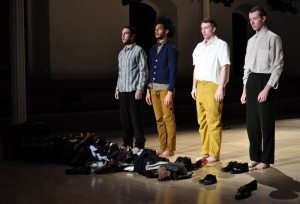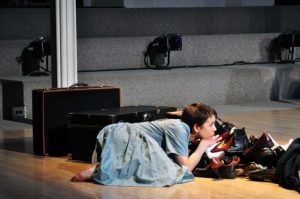

The walls at the St. Mark's Church are thin.
At the Thursday performance of Megan Kendzior's "Witness", a dance work about the Holocaust that explores, in Kendzior's words, "the thin line between the humane and inhumane," moments of silence were thus interrupted by loud voices and brassy music, carried into the performance space from other parts of the building. It felt, at once, entirely inappropriate and somehow fitting. We live in a world of distraction; taking time to remember, voice, and disconstruct the past is essential, yet all-too-easy not to do.
"Witness" began in 2009, and has since gone through many iterations. Kendzior hopes that it will ultimately form the first part of a trilogy. (The other two acts are to be called "Honor" and "Challenge".) At this point in its life, it begins with a checkerboard of shoes -- pumps, scuffed boots, white flats -- spaced evenly across the floor. One pair at the front is so small it could only fit a young child.
Shoes, of course, have become for many an iconic image of the Holocaust: at the Holocaust Memorial Museum in D.C., for example, visitors walk through a room filled with 4,000 shoes that once belonged to victims. As Kendzior's dancers eye the shoes from the edges of the room, varying degrees of emotion can be seen on their faces: some have covered their skin with blankness; others bleed anger and grief from their eyes. Individually, they approach the shoes, pick them up, and deposit them in a pile at the front of the stage. They are many things: tired, skittish, reverent, angry; careful not to let their own shoes make a sound; clacking their heels hard against the ground. They place the shoes on the pile like dirt over a coffin: some laid down with care, others tossed on top without a backwards glance.

This first vignette is one of the work's most moving. As it continues -- sometimes with mournful accordion and violin music, sometimes with song, sometimes in silence -- Kendzior continues to explore the vicissitudes of grief and the reverberations of trauma from the past into the present. At times, the movement itself is so repetitive the dancers' raw emotion dries up into tedium, creating a horribly real break in human connection: how long, Kendzior seems to ask, can we watch others' pain before our empathy wears out? Similarly, the dancers' ability to reach one another seems at times tenuous: at one point, a woman in a red dress (Ariane Reinhart) walks in increasingly frantic circles while those around her try to ignore her; later, she reaches her hands out to a woman dancing out her agony, but her attempts to help are refused. One dancer (Lindsay Head) wanders through the piece out of step with the other dancers; unlike the rest of them, she is barefoot. Is her grief somehow different from theirs? Is she a victim or witness?
Perhaps one of the greatest strengths of Kendzior's dance work is that it blurs the line between victim and witness. At the beginning of the piece, the dancers stare at the shoes with the eyes of those coming to terms with grief. By the end they have shed their shoes (and clothes) as they file offstage. (To a gas chamber?) Head, similarly, could be read as a victim of the Holocaust (she walks through the piece like a ghost) or a witness to the others' death. Thus, the dancers' roles in this tragedy are undefined and undefinable; just when you start to assign them a place in the narrative, the narrative is overturned. Kendzior does not allow us, or herself, the simplicity of linearity: time itself is broken, the possibility of linear narrative irrupted by traumatic experience and memory.
How do we speak (let alone sing, or dance) in the Holocaust's aftermath? When the dancers try to sing, their voices turn from lulling comfort to the strangled voicelessness of nightmares. And yet, in Kendzior's intelligent and nuanced "Witness", she begins to give voice to ideas often left unexplored by this artistic medium.